

1921 : le massacre raciste de Tulsa, un cauchemar américain. L’enfer vient aussi du ciel, avec des avions qui lancent des boules de térébenthine en feu en vue d’incendier les habitations.

Dix ans plus tard, dans un article intitulé « Le racisme aux Etats-Unis », le journal de gauche La République rappelle les événements sanglants. Contrôler l'antibiorésistance. Bumblebees utilize floral cues differently on vertically and horizontally arranged flowers. Biologists Confirm Role of Sperm Competition in Formation of New Species. 'Current Biology' article marks culmination of six years of research A "Drosophila simulans" reproductive tract, following hybrid insemination by a "D. mauritiana" male (red sperm heads) and then remating with a "D. simulans" male (green sperm heads).

Video: The impressive aerial maneuvers of the pea aphid. Tuesday, February 5, 2013 You might not think much about pea aphids, but it turns out they’ve got skills enough to get aerospace engineers excited.
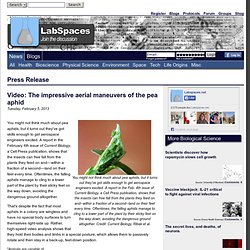
A report in the Feb. 4th issue of Current Biology, a Cell Press publication, shows that the insects can free fall from the plants they feed on and--within a fraction of a second--land on their feet every time. Oftentimes, the falling aphids manage to cling to a lower part of the plant by their sticky feet on the way down, avoiding the dangerous ground altogether. Les dilemmes de l’innovation : pourquoi est-elle peu ou pas responsable ? Jean-Jacques Perrier , le 29 Janvier 2013 dans Actualités Le rapport « Leçons tardives d’avertissements précoces : science, précaution, innovation » , publié le 23 janvier par l’Agence européenne de l’environnement, fourmille d’exemples montrant par quels enchaînements ou par quels manquements des alertes pour la santé humaine et pour l’environnement causées par de nouveaux produits commerciaux ont été négligées pendant des années par les décideurs industriels et politiques.
Au-delà du « comment », l’un de ses chapitres s’intéresse à la question du « pourquoi », et notamment : « Pourquoi le monde des affaires ne réagit-il pas avec précaution aux avertissements précoces ? ». Ceux qui bloguent la science en français (with tweets) · SciencePresse. The trouble with common names. By Dr.
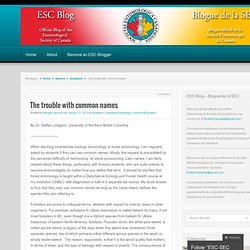
Staffan Lindgren, University of Northern British Columbia When teaching Invertebrate zoology, entomology or forest entomology, I am regularly asked by students if they can use common names. Mostly this request is precipitated by the perceived difficulty of memorizing, let alone pronouncing, Latin names. I am fairly relaxed about these things, particularly with forestry students, who are quite unlikely to become entomologists no matter how you define that term.
It should be clarified that forest entomology is taught within a Disturbance Ecology and Forest Health course at my institution (UNBC), with diagnostics in half of a separate lab course. Foresters are prone to colloquial terms, whether with respect to insects, trees or other organisms. Dung Beetles Navigate Via the Milky Way, An Animal-Kingdom First. Talk about star power—a new study shows that dung beetles navigate via the Milky Way, the first known species to do so in the animal kingdom.
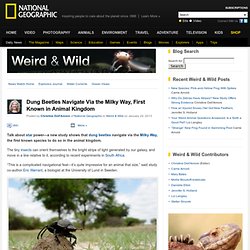
The tiny insects can orient themselves to the bright stripe of light generated by our galaxy, and move in a line relative to it, according to recent experiments in South Africa. “This is a complicated navigational feat—it’s quite impressive for an animal that size,” said study co-author Eric Warrant, a biologist at the University of Lund in Sweden. A dung beetle rolling its ball in South Africa. Photograph courtesy Eric Warrant. Where did all the spiderlings go? A story about egg-sac parasitism in Arctic wolf spiders « Arthropod Ecology. This week we are in a deep freeze in the Montreal area, so it seems somewhat fitting to discuss Arctic spiders.
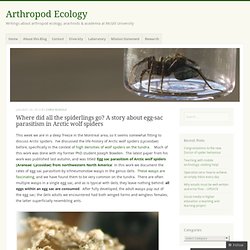
I’ve discussed the life-history of Arctic wolf spiders (Lycosidae) before, specifically in the context of high densities of wolf spiders on the tundra. Much of this work was done with my former PhD student Joseph Bowden. The latest paper from his work was published last autumn, and was titled ‘Egg sac parasitism of Arctic wolf spiders (Araneae: Lycosidae) from northwestern North America‘.
In this work we document the rates of egg sac parasitism by Ichneumonidae wasps in the genus Gelis. These wasps are fascinating, and we have found them to be very common on the tundra. The rates of parasitism of Pardosa egg sacs (by Gelis) were, at some sites, extremely high. It’s quite interesting to think about these wingless Gelis females: after emerging from egg sacs, they end up wandering around the tundra in search of hosts.
Looking down the microscope – all those Gelis! Faire évoluer son association vers des pratiques... Qu'est-ce que l'écologie comportementale? Des températures négatives plus chaudes que l'infini avec des atomes ultrafroids. Parution : Questions de communication, n° 18, « Les non-usagers des TIC » Wasps v moths: Biocontrol uses nature against crop pests. 21 January 2013Last updated at 21:51 ET By Katia Moskvitch Technology reporter, BBC News Humans may consider wasps a pest, but some can be used to protect crops Blinking in the blazing Brazilian sun, a farmer looks up at the sound of an aeroplane, flying low over his sugarcane plantation in Sao Paulo.
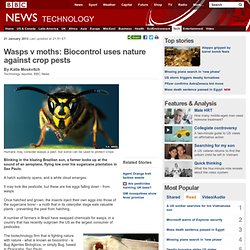
A hatch suddenly opens, and a white cloud emerges. It may look like pesticide, but these are live eggs falling down - from wasps. Once hatched and grown, the insects inject their own eggs into those of the sugarcane borer - a moth that in its caterpillar stage eats valuable plants - preventing the pest from hatching. A number of farmers in Brazil have swapped chemicals for wasps, in a country that has recently outgrown the US as the largest consumer of pesticides. Sugarcane borers eat the plants and can be detrimental to the plantation.